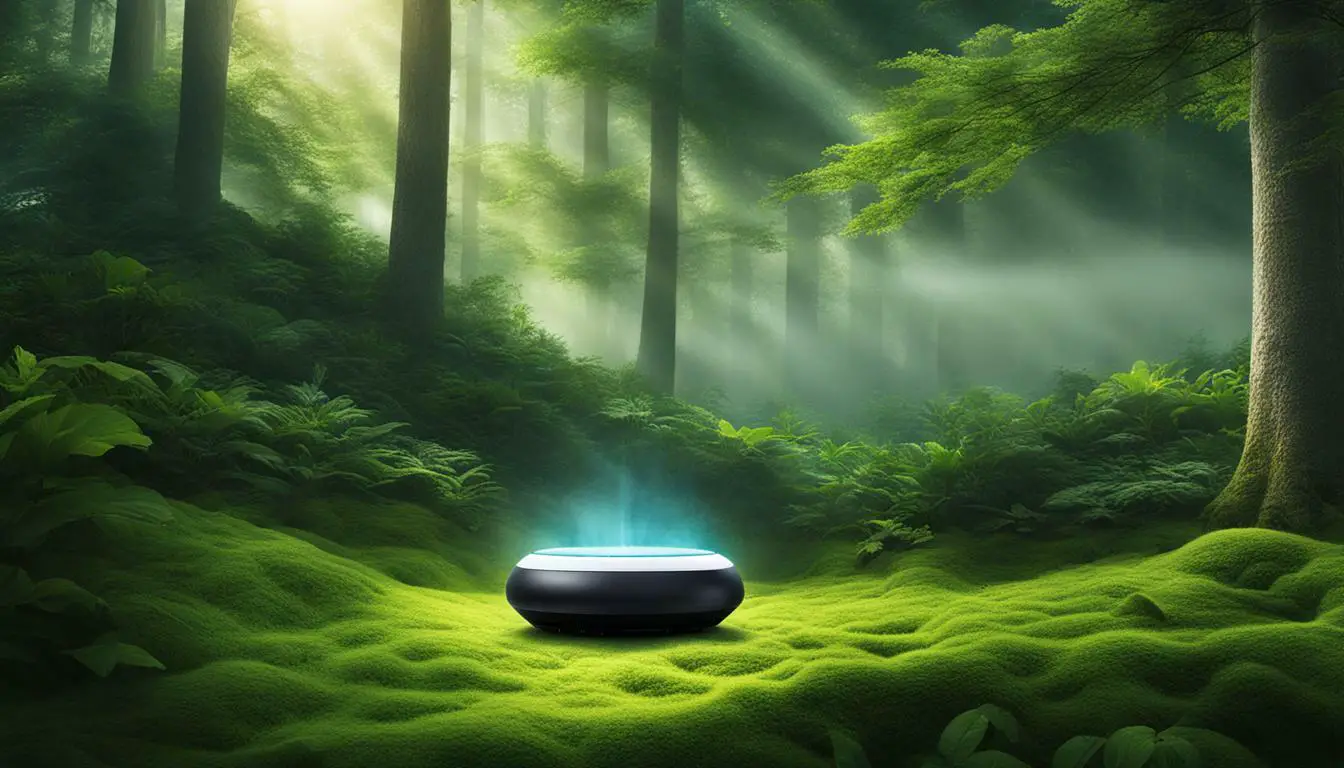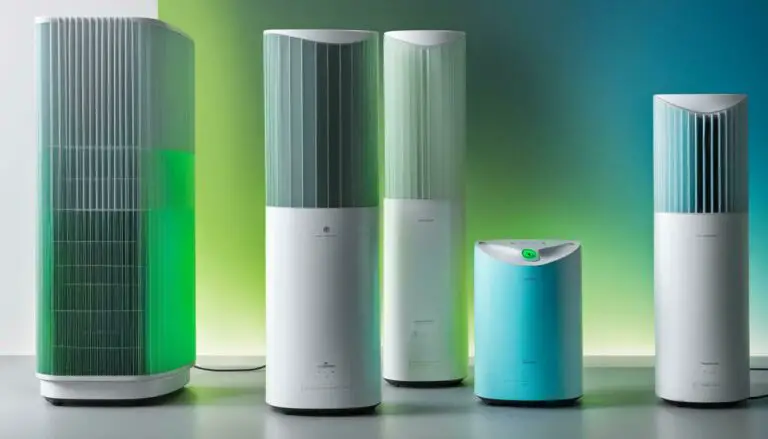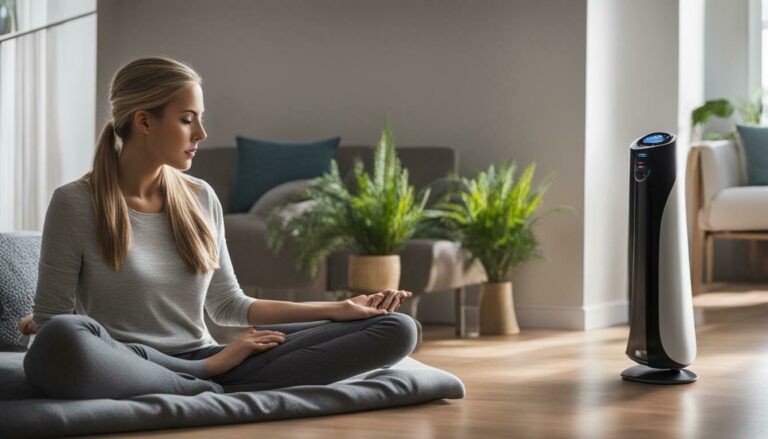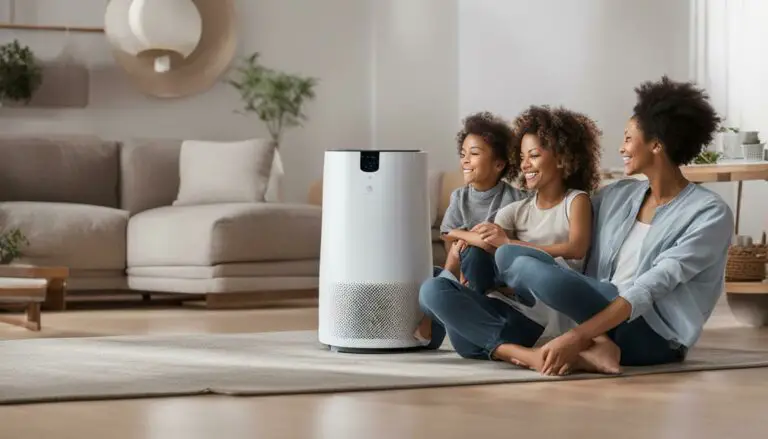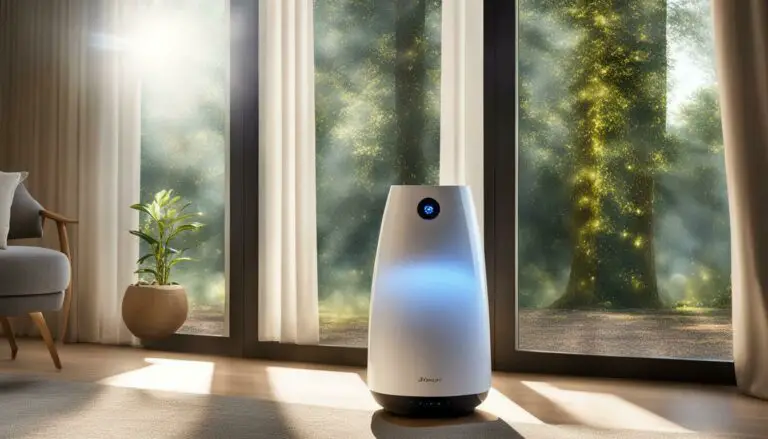Uncover the Environmental Benefits of Ionic Air Purifiers
Indoor air pollution is a growing concern, but ionic air purifiers offer a potential solution by providing clean and fresh air while minimizing harm to the environment. These devices utilize ionization technology to remove harmful air pollutants and improve indoor air quality. While they have gained popularity in the market, recent studies have revealed potential drawbacks and unintended health consequences associated with their use.
Key Takeaways:
- Ionic air purifiers have the potential to remove harmful air pollutants and improve indoor air quality.
- Studies have shown that these devices can create other pollutants, such as volatile organic compounds (VOCs).
- Exposure to VOCs can lead to various health effects, including irritation, headaches, and organ damage.
- The effectiveness and safety of ionizers have received less research and testing compared to traditional air filtration methods.
- Emission of ozone and potential formation of formaldehyde and ultra-fine particles are among the risks associated with ionizers.
- More peer-reviewed research is needed to fully understand the effects and risks of ionic air purifiers.
- Organizations recommend evidence-based measures like high efficiency particle filtration and enhanced ventilation.
Understanding Ionic Air Purifiers and their Technology.
Ionic air purifiers use ionization technology to effectively eliminate air pollutants and allergens, providing a cleaner and healthier indoor environment. These devices work by emitting negative ions into the air, which attach to positively charged particles like dust, pollen, and pet dander. The ionization process causes these particles to become heavy and fall out of the air, effectively removing them from your breathing space. This technology is particularly effective in capturing particles as small as 0.01 microns, making it a powerful tool in improving indoor air quality.
One of the advantages of ionic air purifiers is their ability to neutralize harmful substances such as bacteria, viruses, and mold spores. The negative ions emitted by these devices bind to the surface of these microorganisms, disrupting their structure and rendering them inactive. This helps to reduce the risk of respiratory infections and allergies caused by airborne pathogens.
How Ionization Technology Works
Ionization technology works through a process called corona discharge. Inside the air purifier, a high-voltage electrical current is passed through a series of needles or plates. This electrical charge generates negative ions, which are then released into the air. These ions attach to airborne pollutants and allergens, causing them to become heavier and fall to the ground or adhere to surfaces. Some ionic air purifiers also include collector plates or filters to capture these particles, further enhancing their cleaning efficiency.
| Air Pollutants | Allergens |
|---|---|
| Dust | Pollen |
| Pet dander | Mold spores |
| Smoke particles | Dust mites |
It’s important to note that while ionic air purifiers can effectively remove certain types of airborne pollutants and allergens, they may not be as effective in capturing larger particles or VOCs (volatile organic compounds). In such cases, combining them with traditional air filtration methods, such as HEPA filters, can provide a more comprehensive solution for cleaner indoor air. Additionally, regular maintenance and cleaning of the purifier’s plates or filters is necessary to ensure optimal performance and longevity.
In conclusion, ionic air purifiers offer a unique way to improve indoor air quality by using ionization technology. These devices can effectively eliminate air pollutants and allergens, creating a healthier environment for you and your family. However, it’s important to consider the specific needs of your space and combine different air purification methods for optimal results. By understanding how ionization technology works and its limitations, you can make informed decisions about the best air purifier for your needs.
Examining the Claimed Environmental Benefits
Ionic air purifiers offer an eco-friendly solution to improving air quality by reducing indoor air pollutants and minimizing the release of harmful substances into the environment. These devices use ionization technology to effectively capture and neutralize harmful particles, allergens, and pollutants present in the air. By eliminating these pollutants indoors, ionic air purifiers contribute to cleaner air both inside and outside the home, resulting in numerous environmental benefits.
One of the key environmental benefits of ionic air purifiers is their ability to reduce outdoor air pollution. As these devices effectively remove harmful particles and pollutants from the air, they prevent these pollutants from being released back into the environment, thus lowering overall air pollution levels. This is particularly important in urban areas where outdoor air pollution can be a significant problem.
| Environmental Benefits of Ionic Air Purifiers |
|---|
| – Reduction of outdoor air pollution |
| – Conservation of energy by improving indoor air quality |
| – Minimization of the release of harmful substances into the environment |
| – Contribution to a healthier ecosystem |
In addition to reducing air pollution, ionic air purifiers also contribute to energy conservation. By improving indoor air quality, these devices can help optimize ventilation systems and reduce the need for excessive energy consumption. This not only benefits the environment but also helps save on energy costs.
Furthermore, by minimizing the release of harmful substances into the environment, ionic air purifiers play a crucial role in maintaining a healthier ecosystem. By capturing and neutralizing pollutants and allergens, these devices prevent the spread of harmful particles that can have adverse effects on wildlife, plants, and the overall balance of the environment.
In conclusion, ionic air purifiers offer significant environmental benefits by reducing indoor air pollutants, minimizing the release of harmful substances into the environment, and contributing to a healthier ecosystem. While it is important to acknowledge the potential drawbacks and unintended health consequences associated with these devices, their ability to improve air quality and mitigate air pollution makes them a valuable tool in achieving cleaner, healthier environments.
Unintended Consequences and Potential Health Risks
While ionic air purifiers have their benefits, studies have shown that certain models can produce unintended byproducts, such as increased volatile organic compounds (VOCs), which may pose health risks, especially to individuals with respiratory conditions.
Research has revealed that the ionizing technology employed in these purifiers can have both positive and negative effects on indoor air quality. While it can effectively decrease some VOCs, it can also increase the levels of other harmful compounds, such as oxygenated VOCs and toluene. Exposure to VOCs has been linked to various health effects, including irritation, headaches, and damage to organs.
Furthermore, the effectiveness and safety of these add-on air cleaning methods, like ionization, have not undergone extensive research and testing compared to traditional air filtration methods. The lack of standardized testing and independent data on the health impacts of ionizers raises concerns about substituting one harmful agent for another.
| Risks Associated with Ionizers |
|---|
| Emission of ozone |
| Potential formation of formaldehyde |
| Increased ultra-fine particles |
These risks are of particular concern, as the emission of ozone and the potential formation of formaldehyde can have adverse effects on respiratory health. Ultra-fine particles, on the other hand, can penetrate deep into the lungs and contribute to respiratory issues.
While some studies have shown benefits in inhibiting viruses and improving mood, there is a need for more peer-reviewed research to better understand the effects and risks of ionizers. As a result, organizations like the U.S. Environmental Protection Agency (EPA) and the American Society of Heating, Refrigerating and Air-Conditioning Engineers (ASHRAE) recommend using evidence-based measures like high efficiency particle filtration and enhanced ventilation, along with face coverings and physical distancing, to reduce airborne transmission of COVID-19 and improve indoor air quality.
The Need for Further Research and Alternative Solutions
The lack of comprehensive research and standardized testing on the health effects of ionizers emphasizes the need for alternative air purification solutions, such as traditional air filtration methods, to minimize potential risks and optimize indoor air quality. While ionic air purifiers have gained popularity for their claimed benefits, it is important to consider the potential drawbacks and unintended consequences associated with their use. Studies have shown that these devices can create additional pollutants, including certain volatile organic compounds (VOCs), which can have adverse effects on human health.
Research has found that the ionization technology used in these purifiers can decrease some VOCs while increasing others, such as oxygenated VOCs and toluene. Exposure to VOCs has been linked to respiratory irritation, headaches, and damage to organs. With limited research and testing on the effects of ionizers, there is a concern that we may be substituting one harmful agent for another. Additionally, the emission of ozone and the potential formation of formaldehyde and ultra-fine particles are among the risks associated with the use of ionizers.
To ensure a safer and healthier indoor environment, organizations like the U.S. Environmental Protection Agency (EPA) and the American Society of Heating, Refrigerating, and Air-Conditioning Engineers (ASHRAE) recommend using evidence-based measures such as high efficiency particle filtration and enhanced ventilation. These traditional air filtration methods have been extensively studied and proven effective in improving indoor air quality. Alongside these measures, practices like wearing face coverings and practicing physical distancing can further reduce the risk of airborne transmission, particularly during the COVID-19 pandemic.
While some studies have shown potential benefits of ionizers in terms of inhibiting viruses and improving mood, it is crucial to gather more peer-reviewed research to fully understand the effects and risks associated with these devices. Until then, it is prudent to prioritize alternative and scientifically proven air purification solutions to ensure the health and well-being of individuals in indoor environments.
| Key Points: |
|---|
| – Ionic air purifiers lack comprehensive research and standardized testing on their health effects. |
| – The ionization technology used in these purifiers can increase certain VOCs and pose health risks. |
| – Organizations like the U.S. EPA and ASHRAE recommend traditional air filtration methods. |
| – Face coverings, physical distancing, and enhanced ventilation are additional measures for improving indoor air quality. |
Conclusion
In conclusion, while ionic air purifiers may offer some environmental benefits, it is important to consider the potential unintended consequences and health risks associated with their use, as well as explore alternative air purification methods to ensure clean indoor air and protect our environment.
Factual data shows that these popular devices, marketed for their ability to remove harmful air pollutants and kill bacteria and viruses, have been found to have potential drawbacks and unintended health consequences. Studies conducted by researchers have revealed that ionizing technology used in these purifiers can actually create a suite of other pollutants when used in real-world conditions.
Exposure to volatile organic compounds (VOCs), which can increase when using ionizers, has been linked to various health effects, including irritation, headaches, and damage to organs. Furthermore, the lack of standardized testing and independent data on the health impacts of ionizers raises concerns about substituting one harmful agent for another. The emission of ozone and the potential formation of formaldehyde and ultra-fine particles are among the risks associated with ionizers.
While some studies have shown benefits in inhibiting viruses and improving mood, there is a need for more peer-reviewed research to better understand the effects and risks of ionizers. Organizations like the U.S. Environmental Protection Agency (EPA) and the American Society of Heating, Refrigerating and Air-Conditioning Engineers (ASHRAE) recommend using evidence-based measures like high efficiency particle filtration and enhanced ventilation, along with face coverings and physical distancing, to reduce airborne transmission of COVID-19 and improve indoor air quality.
By considering all these factors, it becomes evident that exploring alternative air purification methods, such as traditional air filtration, can provide a more reliable and well-researched approach to ensuring clean indoor air and protecting our environment. By relying on evidence-based measures, we can prioritize the health and well-being of individuals while also minimizing potential risks and negative impacts on our surroundings.
FAQ
Are ionic air purifiers effective in removing air pollutants?
While ionic air purifiers are marketed as effective devices for removing air pollutants, studies have shown that they may create other pollutants when used in real-world conditions. It is recommended to rely on evidence-based measures like high efficiency particle filtration and enhanced ventilation for effective air purification.
Do ionic air purifiers have any potential health risks?
Yes, studies have found that ionic air purifiers can increase the levels of certain volatile organic compounds (VOCs), which can have negative effects on respiratory health. Additionally, the emission of ozone and the potential formation of formaldehyde and ultra-fine particles are among the risks associated with ionizers.
Are there alternative solutions to ionic air purifiers?
Yes, organizations like the U.S. EPA and ASHRAE recommend using evidence-based measures such as high efficiency particle filtration and enhanced ventilation to improve indoor air quality. These methods have undergone more standardized testing and research compared to ionizers.
Are there any environmental benefits of using ionic air purifiers?
While ionic air purifiers claim to have environmental benefits by reducing outdoor air pollution, it is important to note that there is a lack of research and standardized testing on their effectiveness and safety. Therefore, alternative air purification methods are recommended to achieve clean indoor air.
Are there any known health effects associated with exposure to VOCs?
Exposure to volatile organic compounds (VOCs) has been linked to various health effects, including irritation, headaches, and damage to organs. It is important to minimize exposure to VOCs in order to maintain good respiratory health.
Is there a need for further research on ionic air purifiers?
Yes, there is a need for more peer-reviewed research to better understand the effects and risks of ionic air purifiers. The lack of standardized testing and independent data on their health impacts raises concerns about substituting one harmful agent for another.
